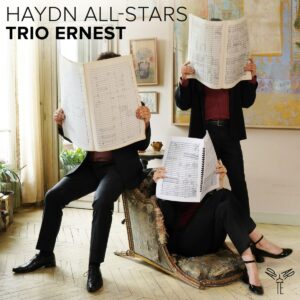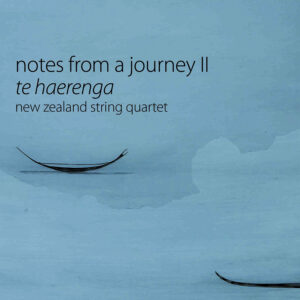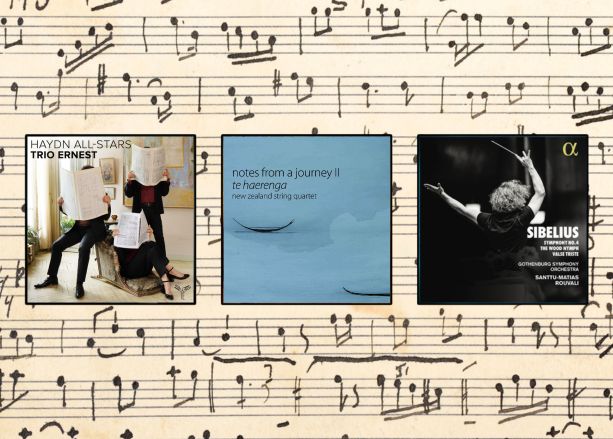With the arrival of autumn the nights grow longer, providing an ideal opportunity to listen to more music. This blog explores a selection of the new classical CDs we added to our collection in April, each offering rarities and innovation. Two of these recordings feature artists and composers well-known in Wellington: Amalia Hall, concertmaster of Orchestra Wellington, and Christopher Park have recorded works for violin and piano by Philipp Schwarenka, while the New Zealand String Quartet, an ensemble-in-residence at Victoria University of Wellington, offers a second installment of notes from a journey featuring new works by New Zealand composers. A new recording of an Offenbach opéra-bouffe will transport you to nineteenth-century Paris, while the Gothenburg Symphony Orchestra navigates Sibelius’s ‘psychological’ symphony, and Le Consort reveals that there is always more to Vivaldi than we expect. Read, listen, and enjoy!
 Haydn All-Stars / Trio Ernest
Haydn All-Stars / Trio Ernest
Trio Ernest (violinist Stanislas Gosset, pianist Natasha Roque Alsina, and cellist Clément Dami) formed in 2019, and for the last five years they have been busy touring and performing, immediately attracting attention for their imaginative programming. Haydn All-Stars is a recording project built around four piano trios by Joseph Haydn— the composer who transformed the piano trio from its early existence as a piano work with violin and cello accompaniment or obligato into a more complex form, establishing a meaningful voice for each instrument so that the piano trio might become a sublime form of musical discourse. Trio Ernest interleaves between the Haydn trios several pieces that offer homage or allusion to Haydn’s music. Brahms’s song ‘Immer leiser wird mein Schlummer’ and Ravel’s Menuet sur le nom de Haydn, both arranged for piano trio by Carlos Roque Alsina, and Jaqueline Fontyn’s Lieber Joseph! each respond to Haydn’s music in enigmatic ways. Trio Ernest offers precise and expressive performances of each work, demonstrating the individual prowess and thoughtful ensemble that have earned the Trio prize and accolades over the last five years.
 notes from a journey II : te haerenga / New Zealand String Quartet
notes from a journey II : te haerenga / New Zealand String Quartet
In 2011 the New Zealand String Quartet released Notes from a Journey, comprising five works by New Zealand composers written between 2015 and 2021. Last year a second volume followed, notes from a journey ii: te haerenga. Some of these pieces — Tabea Squire’s I Danced, Unseen, Ross Harris’s String Quartet No. 9, and Gillian Whitehead’s Poroporoaki — formed part of the NZSQ’s 2023 ‘Woven Pathways’ national tour, while the pieces by Gareth Farr, Salina Fisher, and Louise Webster are favourites from earlier performances. The works recorded here have emerged from a variety of sources: I Danced, Unseen began its life as a collaboration between the NZSQ, Dance Collective Aotearoa, and choreographer Loughlan Prior, while Whitehead’s Poroporoaki and Fisher’s Tōrino respond in different ways to taonga pūoro. Ross Harris’s String Quartet No. 9 exhibits a distilled postmodern plurality in its chorale-based archism and subsequent fragmentation. The journey through these works is also a portrait of the richness of talent and imagination among New Zealand composers, performed by musicians whom they know as friends.
 Concerti per una vita / Vivaldi, Antonio
Concerti per una vita / Vivaldi, Antonio
In this two-disc set, violinist Théotime Langlois de Swarte and Le Consort, set out to overturn the cliché that ‘Vivaldi composed the same concerto 500 times’. To demonstrate the extraordinary imaginative riches of Vivaldi’s imagination, Le Consort presents some familiar pieces alongside three ‘premieres’ (yes, new works, or parts of hitherto incomplete works by Vivaldi are still turning up). Especially notable are the Concerto in E-flat major, RV 250, and the five-movement Concerto in B minor, RV37a. To leaven this embarrassment of riches, the ensemble has included some short pieces by Legrenzi, Westhoff, and Jean-Joseph Mouret. Théotime Langlois de Swarte’s impressive virtuosity is matched by that of Le Consort, an army of generals attuned to the chiaroscuro of Vivaldi’s music.
 Works for violin and piano / Scharwenka, Philipp
Works for violin and piano / Scharwenka, Philipp
Amalia Hall, well-known locally as the Concertmaster of Orchestra Wellington, violinist of the New Zealand Trio, and a frequent soloist with the Orchestra, met pianist Christopher Park at the Arte Musica Foundation in Frankfurt in 2016. Since then they have collaborated on a recital tour of New Zealand, and Park has also been a soloist in Béla Bartók’s first Piano Concerto with Orchestra Wellington. On this new recording on the Atoll label, Hall and Park perform two sonatas and a suite by the Polish composer and teacher Philipp Scharwenka (1847–1917). Somewhat overshadowed by his younger brother Xaver, Philipp was nevertheless a good composer whose music was respected by his peers, among them Hans Richter, Arthur Nikisch, and Max Reger. Much of Scharwenka’s working life was spent as director of the Scharwenka Conservatories in Berlin and New York, established by his brother, but despite the demands of administration and teaching, he found time for composition. In 1880 Scharwenka married Marianne Stresow, an outstanding professional violinist, and it seems likely that the three compositions on this recording—Scharwenka’s Sonata in B minor, Op. 110, Sonata in E minor, Op. 114, and Suite for Violin and Piano, Op. 99—may have been composed with Marianne in mind (although the Op.110 and Op. 114 Sonatas were dedicated to violinists Willy Burmester and Irmgard Sänger-Sèthe respectively, and the Suite to pianist Annie Neumann-Hofer). Amalia Hall and Christopher Park give committed accounts of each work, demonstrating that the pieces Hall describes as ‘Evocative and gorgeous’ deserve a more permanent place in the nineteenth-century duo repertoire.
 La princesse de Trébizonde / Offenbach, Jacques
La princesse de Trébizonde / Offenbach, Jacques
This neglected but effervescent opéra bouffe premiered in Baden-Baden in a two-act version in July 1869 when Germany and Austria were all agog for the satirical pleasures of Offenbach’s comedies. Offenbach subsequently revised Trébizonde for performance at the Bouffes-Parisiennes, extending the piece to three acts. This new recording, with conductor Paul Daniel, the London Philharmonic Orchestra, the Opera Rara chorus, and a gifted cast of principals, brings us the three-act version, but with several ‘bonus tracks’ of music that Offenbach cut during his revisions. The satire in Trébizonde is less cutting than the critiques of Second Empire moral corruption that shape Orphée aux enfers, La belle Hélène, and La Grande-Duchesse de Gérolstein, but Offenbach and his librettists Etienne Tréfieu and Charles-Louis-Etienne Nuitter still find targets for mockery. The plot concerns Cabriolo, the proprietor of a funfair sideshow, and the several members of his family who work with him. Within the sideshow is a waxwork of the ‘Princess Trebizonde’ and after Cabriolo’s daughter Zanetta breaks the waxwork’s nose while dusting it overzealously, she must impersonate the Princess instead. When Prince Raphaël sees the ‘waxwork’ he becomes smitten by her. Meanwhile, Cabriolo wins a castle in a lottery and joins the nobility. However, his family finds castle life very tedious, and Raphaël realizes he has fallen in love with the daughter of a circus man, an association that his father Casimir would never allow. The social satire anatomizes Cabriolo’s social elevation, and Casimir’s hauteur with the scabrous wit. The success of such a piece as La princess de Trébizonde depends very much on the panache of the performers, and thanks to the energy of the cast and their ease with the Offenbach style (which relies heavily on the witty delivery of the text), this recording triumphs. The principals and chorus commit themselves entirely to the comedy, without falling prey to grotesquerie, while the London Philharmonic revels in the inherent humorousness inherent of Offenbach’s music. The recording is accompanied by a booklet containing a good translation of the libretto and a succinct introductory essay by Jean-Christoph Keck.
 Symphony No. 4 ; The Wood Nymph ; Valse Triste / Sibelius, Jean
Symphony No. 4 ; The Wood Nymph ; Valse Triste / Sibelius, Jean
Jean Sibelius’s Symphony No. 4 is the most enigmatic and complex of his seven symphonies. The composer called it ‘a psychological symphony’, writing to his friend Rosa Newmarch that the piece ‘stands as a protest against present-day music. It has absolutely nothing of the circus about it.’ In writing these words, Sibelius alluded to his recent travels in western and central Europe, where he’d heard the most recent expressions of musical modernism—although now the first decade of the twentieth century is regarded as the final flourish of the latest Romanticism—and the experience that shook Sibelius’s confidence in his own music and in the future of music more generally. Sibelius composed the Fourth Symphony between 1909 and 1911, its premiere taking place in Helsinki on 3 April 1911. This new recording, part of a Sibelius series by the Gothenburg Symphony Orchestra and their Chief Conductor Santtu-Matias Rouvali, offers a carefully considered but sometimes hasty-sounding account of the Symphony that emphasizes the challenges of the work while bringing to mind the composer’s reflection in his diary that the piece ‘really is too subtle and tragic for our miserable world.’ However, the collective artistry of the Gothenburg musicians compensates, especially in The Wood Nymph, a Sibelius tone poem that premiered in 1895 but was lost to the repertory from 1936 until 1996. Completing this recording is Sibelius’s gloriously macabre Valse Triste.


